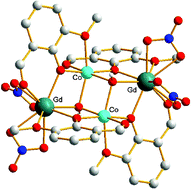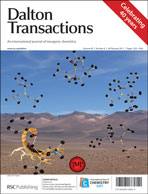The syntheses, structural determinations and magnetic studies of tetranuclear CoII–LnIII complexes (Ln = Y, Gd, Tb) involving orthovanillin as main ligand are described. The structural studies demonstrate that centrosymmetric tetranuclear Co2–Ln2 complex molecules with a defect-dicubane central core are obtained, with hexacoordinate Co ions in deformed octahedral environments and nine-coordinate lanthanide ions. The Co ions are linked by two hydroxo bridges and each Co ion is also involved in a double phenoxo-hydroxo bridge with the two Ln ions, so that each hydroxo group is triply linked to the two Co and one Gd ions. The four metal ions are coplanar. A ferromagnetic Co–Ln interaction operates in the Co2–Ln2 complexes (Ln = Gd, Tb), along with a D zero-field splitting term for the cobalt ion and a weak ferromagnetic Co–Co interaction. The SMM behaviour of the Co2–Gd2 complex is confirmed by observation of hysteresis loops, as a consequence of the slowing down of relaxation for this tetranuclear complex. The Co2–Tb2 complex does not behave as a SMM, what could result from a subtractive combination of the Tb and Co anisotropies and an increased transverse anisotropy, leading to large tunnel splittings and quantum tunneling of magnetization.

You have access to this article
 Please wait while we load your content...
Something went wrong. Try again?
Please wait while we load your content...
Something went wrong. Try again?


 Please wait while we load your content...
Please wait while we load your content...